Accepted Scientific Name: Ananas comosus (L.) Merr.
Interpr. Herb. Amboin. 133. 1917 Merr.
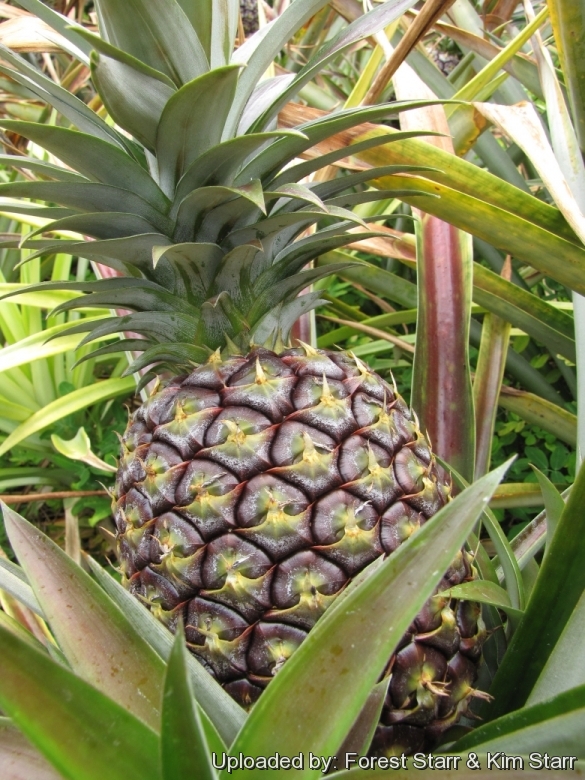
Bromelia comosa (Ananas comosus) Photo by: Forest Starr & Kim Starr
White var Kona Sugarloaf fruit at Laulima Farm Kipahulu, Maui, Hawaii (USA). June 06, 2012
Origin and Habitat: It is a cultigen not known in the wild presumably originated from the area between Southern Brazil and Paraguay, South America. It is a pantropical plant widely grown for its edible fruits that has been cultivated in South America since the fifteenth century and now it is intensively cultivated in several tropical countries, such as Hawaii, India, Malaysia, Philippines and Thailand.
Synonyms:
See all synonyms of Ananas comosus
back
Accepted name in llifle Database:Ananas comosus (L.) Merr.Interpr. Herb. Amboin. 133. 1917Synonymy: 91
back
Common Names include:
ENGLISH: Pineapple
ALBANIAN (Shqip): Ananasi
ANGLO-SAXON (Ænglisc): Pīnæppel
ARABIC ( لعربية ): أناناس, أناناس وبري
AYMARA (Aymar aru): Achupalla
AZERBAIJAN ( Azərbaycanca): Əsl ananas
BANJAR (Bahasa Banjar): Kanas
BANYUMASAN (Basa Banyumasan): Nanas
BASQUE (Euskara): Anana
BENGALI (বাংলা): Annachi Pazham, আনারস
BOSNIAN (bosanski / босански): Ananas
BULGARIAN (Български): Ананас
CANTONESE (粵語): 菠蘿
CATALAN (Català): Pinya americana, Pinya tropical, Ananàs
CHEYENNE: Šéstotó'emeno
CHINESE (中文): 菠萝
CHITUMBUKA: Chinanazi
CROATIAN (Hrvatski): Ananas
CZECH (Čeština): Anansovník Chocholatý, Ananasovník chocholatý, Ananas
DANISH (Dansk): Almindelig Ananas
DUTCH (Nederlands): Ananas
ESPERANT (Esperanto): ananasarbusto (planto), ananaso (frukto)
FINNISH (Suomi): Ananas, Hedelmäananas
FRENCH (Français): Ananas, Pomme de Pin
GALICIAN (Galego): Ananás, Piña
GERMAN (Deutsch): Ananas
GREEK (Ελληνικά): Ανανάς
HAITIAN CREOLE (Kreyòl ayisyen): Zannanna, Bayonèt pengwen, Zannanna pengwen, Zalanna, Anana
HAUSA (Harshen Hausa هَرْشَن هَوْسَ ): Abarba
HEBREW (עברית): אננס
HINDI ( हिन्दी): अनानास
HUNGARIAN (Magyar): Ananász
ICELANDIC (Íslenska): Ananasplöntu, Granaldin, Ananas
IDO: Ananaso
INDONESIAN (Bahasa Indonesia): Nanas, Ananas, Nenas
ITALIAN (Italiano): Ananasso, Ananas
JAPANESE (日本語): パイナップル
KANNADA (ಕನ್ನಡ): ಅನಾನಸ್
KOREAN (한국어): 파인애플
LATVIAN (Latviešu): Ananass, Pušķu ananass, Kultūras ananass
LITHUANIAN (Lietuvių): Valgomasis ananasas
LOWER SORBIAN (Dolnoserbski): Ananas
MALAY (بهاس ملاي /Bahasa Melayu ): Nenas, Nanas
MALAYALAM (മലയാളം): Kaitha Chakka
MALDIVIAN: އަލަނާސި
MANX (Gaelg/Gailck): Annane
MARATHI (मराठी): अननस (ananas)
MIN NAN (Bân-lâm-gú): Ông-lâi, n̂g-lâi
MONGOL (Монгол ): Хан боргоцой
NAHUATL (Nāhuatl): Matzatli, Matzahtli
NAVAJO (Diné Bizaad): Hosh łikaní, Bilasáana diwozhí
NEPALESE (Nepal bhasa नेपाल भाषा): भुइँ कटहर
ORIYA (ଓଡି଼ଆ): ସପୁରି ପଣସ (Sapuri-PaNasa)
PERSIAN (فارسی): آناناس
POLISH ( Polski): Ananas Jadalny
PORTUGUESE (Português): Abacaxi, Ananás, Gravatá, Ananás-selvagem, Abacaxi-do-mato
QUECHUA (Runasimi / Qhichwa simi): Chirimaway
ROMANIAN (Română): Ananasul, Ananas
RUSSIAN (Русский): Ананас крупноxоxолковый, Анана́с xоxла́тый, Анана́с настоя́щий
SAMOAN (Gagana Samoa): Pineapu
SAMOGITIAN (Žemaitėška): Ananasos
SANSKRIT (संस्कृतम्): अनानस् फलम्
SERBIAN (Српски / Srpski): Ананас
SLOVAK (Slovenčina): Ananás pestovaný
SLOVENIAN (Slovenščina): Ananas
SPANISH (Español): Piña, Ananás, Ananá, Piña de Agua, Piña Azucarada, Piña Blanca (Colombia), Piña tropical, Piña de América
SUNDANESE (Basa Sunda): Ganas, Danas
SWEDISH (Svenska): Ananas
TAGALOG: Pinya
TAJIK (Тоҷикӣ / تاجیکی/ toçikī ): Ананас
TAMIL (தமிழ்): Annachi Pazham, அன்னாசி
TELUGU (తెలుగు): అనాస (Anaasa)
THAI (ภาษาไทย): สับปะรด
TIBETAN (བོད་ཡིག་): ཐང་འབྲས།
TONGAN (Faka-Tonga): Fainā
TURKISH (Türkçe): Ananas
UKRAINIAN (Українська): Ананас
UPPER SORBIAN (Hornjoserbsce): Ananas
URDU (اردو): انناس
VIETNAMESE (Tiếng Việt): Dứa, Thơm, Khóm
YIDDISH (ײִדיש / מאַמע לשון ): אנאנאס
ZAZAKI (Zazaki): Ananas
Description: Ananas comosusSN|12309]] (pineapple) is one of the most popular tropical fruits in the world and the most economically important plant in the Bromeliaceae family. The pineapple is named for its resemblance to the pine cone. But native West Indians Tupian called it na-na, from which its botanical name (Ananas) comes.
Habit: It is an highly variable xerophyte, semi-rerennial, herbaceous terrestrial bromeliad characterized by its large edible fruit born on a wide and strong peduncle
Stem: Very short, thick, condensed and stocky.
Rosette: 0,7-1,5 meters tall and 0,9-1,2 m meters wide (although sometimes it can be taller) with about 30-60 (or more) leaves whorled in close spirals. The near vertical positioning of the leaves help conduct of water falling on them to the base of plant where it is absorbed through trichomes (short hairs) at basal part of rosette. The leaf production ceases by flowering.
Leaves: 30 to 180 centimetres long and up to 5 cm wide, strap-like, narrow, fleshy, trough-shaped, waxy, green in the upper surface and silvery white or light green in the lower surface due to the presence of minuscule hairs called as trichomes, spines antrorse if present and generally denser than in other botanical varieties. Certain cultivars are partially spiny or even completely smooth.
Inflorescence: Large, from the centre of the rosette of leaves, spike-like up to 15 cm long, many-flowered (usually produces 100 to 200 flowers, although some large-fruited cultivars can exceed this). Scape stout, usually 2 cm or more in width and less than 40 cm in length. The flowers are spirally arranged, trimerous, each subtended by a bract. Flower colours vary, depending on variety, from lavender, through light purple to red. Floral bracts inconspicuous, soon exposing.
the apices of the ovaries, weakly serrulate or entire. Opening of flowers takes places from base to apex, taking about 10-20 days for completion. Flowers are usually self-sterile and fruits develop parthenocarpically.
Fruit: After anthesis the individual ovaries of the flowers develop appreciably into berries that join together to create what is referred to as a fleshy syncarp (large, compact, multiple accessory fruit) or pineapple and reach a final size several times superior to that of the inflorescence (up to several kilograms in some cultivate); The tough waxy rind of the fruit is made of hexagonal units, called as “eyes” arranged in two interlocking helices, eight in one direction, thirteen in the other, each being a Fibonacci number. The pineapple skin will be dark tannish-green, yellow, orangish or reddish when fruit is ripe. Flesh colour ranges from near white to golden yellow. If flowers are pollinated, small seeds can be seen in the flesh. Unlike many other fruits, pineapple does not ripen post harvest, so it is picked when it is ripe.
Seeds: Usually rare because most cultivars present reduced fertility combined with self-incompatibility.
Remarks: The commercial pineapple (Anans comosus), is probably a hybrid derived from the intersection of Ananas sagenariaSN|12312]]SN|24055]] (Pseudananas sagenariusSN|24059]]SN|24059]]), Ananas ananasSN|24055]]SN|12312]]soides, Ananas comosusSN|12309]] and other more wild pineapples that are found in the same geographical region, but in different ecological niches. The result of the intersection is the current commercial pineapple, a hybrid of better quality than their predecessors.
Notes: Pineapple carries out CAM photosynthesis, fixing carbon dioxide at night and storing it as the acid malate and then releasing it during the day, aiding photosynthesis.
Bibliography: Major references and further lectures
1) Forest & Kim Starr “Ananas comosus (Pineapple)”. Plants of Hawaii. <http://www.starrenvironmental.com>. Downloaded on 20 August 2014.
2) D. P. Bartholomew, Robert E. Paull, K. G. Rohrbach “The Pineapple: Botany, Production, and Uses” CABI, 20/nov/2002
3) James Cullen, Sabina G. Knees, H. Suzanne Cubey “The European Garden Flora Flowering Plants: A Manual for the Identification of Plants Cultivated in Europe, Both Out-of-Doors and Under Glass” Cambridge University Press, 11/Aug/2011
4) Wikipedia contributors. "Ananas comosus" Wikipedia, The Free Encyclopedia. Wikipedia, The Free Encyclopedia, 21 Aug. 2014. Web. 21 Aug. 2014
5) Smith, L.B. & R. J. Downs. 1979. “Bromelioideae (Bromeliaceae)”, Part III. Fl. Neotrop. 14(3): 1493–2142.
6) Rauh, W. 1981. “Bromelien”. 327.
7) Smith, L. B. & R. J. Downs. 1979. “Bromelioideae (Bromeliaceae).” In: Organization for Flora Neotropica, ed., Fl. Neotrop. Monogr. 14(3):2052–2054.
8) Kramer, Jack (1976). "Bromeliads The Colorful House Plants." Litton Educational Publishing, Inc. pp. 33; 100.
Padilla, Victoria (1973). "Bromeliads". New York: Crown Publishers. p. 32.
9) Coppens d'Eeckenbrugge, Geo; Freddy Leal (2003). "Chapter 2: Morphology, Anatomy, and Taxonomy". In D.P Bartholomew, R.E. Paull, and K.G. Rohrbach. “The Pineapple: Botany, Production, and Uses”. Wallingford, UK: CABI Publishing. p. 21.
10) K.F. Baker, J.L. Collins, "Notes on the distribution and ecology of Ananas and Pseudananas in South America", American Journal of Botany, 1939;
11) Collins, “The pineapple: botany, utilization, cultivation” (London:Leonard Hill) J L. 1960
12) Kochhar, S. L. (2006). “Economic Botany in the Tropics.” Macmillan India. p. 203.
13) Francesca Beauman, “The Pineapple”, publisher Chatto and Windus
14) Menzel, Christopher. "Tropical and Subtropical Fruit." Encyclopedia of Agricultural Science—Volume 4. Charles J. Arntzen. New York, NY: Academic Press, 1994. 380–382.
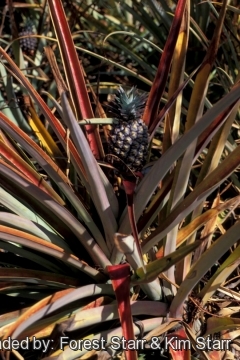 Fruit at Enchanting Floral Gardens of Kula, Maui, Hawaii (USA). May 29, 1998 (Ananas comosus) Photo by: Forest Starr & Kim Starr
Fruit at Enchanting Floral Gardens of Kula, Maui, Hawaii (USA). May 29, 1998 (Ananas comosus) Photo by: Forest Starr & Kim Starr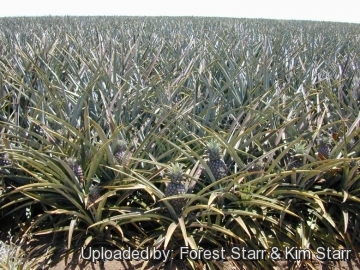 Field at Makawao, Maui, Hawaii (USA). June 30, 200 (Ananas comosus) Photo by: Forest Starr & Kim Starr
Field at Makawao, Maui, Hawaii (USA). June 30, 200 (Ananas comosus) Photo by: Forest Starr & Kim Starr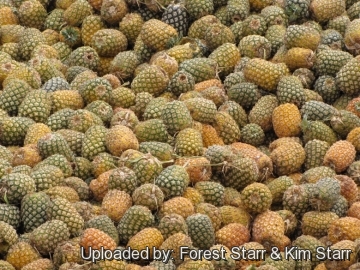 Lots of fruit at Ulupalakua Ranch, Maui, Hawaii (USA). June 29, 2010 (Ananas comosus) Photo by: Forest Starr & Kim Starr
Lots of fruit at Ulupalakua Ranch, Maui, Hawaii (USA). June 29, 2010 (Ananas comosus) Photo by: Forest Starr & Kim Starr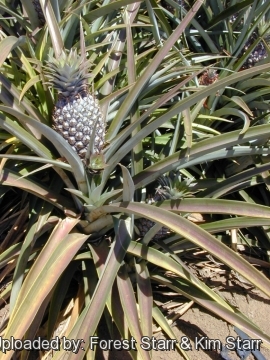 Leaves and fruit at Makawao, Maui, Hawaii (USA). June 30, 2002 (Ananas comosus) Photo by: Forest Starr & Kim Starr
Leaves and fruit at Makawao, Maui, Hawaii (USA). June 30, 2002 (Ananas comosus) Photo by: Forest Starr & Kim Starr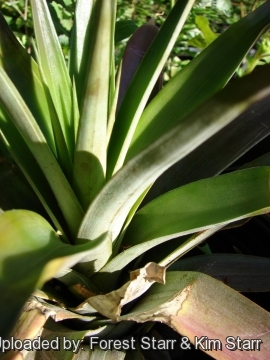 Habit at Makawao, Maui, Hawaii (USA). October 31, 2008 (Ananas comosus) Photo by: Forest Starr & Kim Starr
Habit at Makawao, Maui, Hawaii (USA). October 31, 2008 (Ananas comosus) Photo by: Forest Starr & Kim StarrSend a photo of this plant.The gallery now contains thousands of pictures, however it is possible to do even more. We are, of course, seeking photos of species not yet shown in the gallery but not only that, we are also looking for better pictures than those already present.
Read More... Cultivation and Propagation: Ananas comosusSN|12309]]SN|12309]] is a valuable ornamental bromeliads due to the beauty of the foliage and of the inflorescence, fruit and the facility of cultivation.
Growing substrate: It requires a well-drained, aerated, porous and moisture-retentive substratum which is rich of organic substance (e.g. 2 parts peat moss to 1 part loam to 1 part sand or perlite). Use only acidic soil. Root rot can be a problem if the soil is too moist.
Exposition: It prefers prefers a sunny site but tolerates partial shade.
Watering: It enjoys constant moderate moisture from rain or sprinkler, but allow the plant to dry in-between waterings. However it is quite drought-tolerant and may be also planted in dry succulent plant gardens, whilst in winter it is better to leave it dry, thus avoiding possible rottenness. In dry and hot climate, humidity can be increased with nebulisations utilizing water at room temperature and not calcareous. Requires complete and perfect drainage.
Fertilizing: Fertilize every 4-week during the growing season with a balanced fertilizer diluted to ½ the strength recommended on the label. Apply mild solutions of foliar fertilizer at 3-month intervals to both garden and container plants.
Hardiness: It is cultivated in open air in the tropical and humid subtropical climate countries, with temperatures which it is good to keep over the 14°C, best 20-24°C , but can withstand light frost for short periods if very dry (hardy down to -2 to -4º C, even if with damage to the foliage) in these situations it will better resist if sheltered by the winter rains, seen that the humidity and low temperatures render it more sensitive to rottenness. USDA Zone 9b - 11.
Pruning: Remove old leaves from plant base and dead flower spikes only. Remove older plant crown when it begins to fade.
Pests and diseases: Some pests that commonly affect pineapple plants are mealybug, scales, thrips, mites, ants, and symphylids. Diseases include pink disease, bacterial heart rot, anthracnose and fungal heart rot, root rot, black rot, butt rot, fruitlet core rot, and yellow spot virus.
Food uses: Pineapple may be consumed fresh, canned, juiced, and are found in a wide array of food stuffs dessert, fruit salad, jam, yoghurt, ice cream, candy, and as a complement to meat dishes.
Garden use: Specimen plant; mass planting; container plant; tropical foliage and colourful flowers. Some ornamental varieties, including variegated cultivars are very valuable landscape plants that require very little care and create exotic tropical look.
Other uses: In addition to consumption the pineapple's leaves are used as the source of a textile fibre, and is employed as a component of wall paper and furnishings, amongst other uses.
Propagation: Remove and replant stout offshoots from the base of the parent plant. In addition after the first fruit is produced, side shoots (called 'suckers' by commercial growers) are produced in the leaf axils of the main stem. These may be removed for propagation, or left to produce additional fruits on the original plant. Starting from division 2-3 years are needed for the blossoming. It can also be grown from seed: remove seeds from inflorescence and lay them uncovered on a bed of crushed tree fern fiber; keep constantly but moderately moist.
Warning: Plant has spines or sharp edges that deter some gardeners; use extreme caution when handling.














